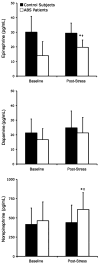Endothelial function and vascular response to mental stress are impaired in patients with apical ballooning syndrome
- PMID: 21087714
- PMCID: PMC3786427
- DOI: 10.1016/j.jacc.2010.03.107
Endothelial function and vascular response to mental stress are impaired in patients with apical ballooning syndrome
Abstract
Objectives: The aim of the current study was to test the hypothesis that vascular and endothelial functional responses to acute mental stress are abnormal in patients with apical ballooning syndrome (ABS).
Background: Apical ballooning syndrome is a transient cardiomyopathy that occurs predominantly in post-menopausal women and may be triggered by acute mental stress. The mechanism for ABS is unknown.
Methods: Reactive hyperemia as a parameter of endothelial function and vascular responses to acute mental stress were measured using peripheral arterial tonometry (PAT) at baseline and following 3 acute mental stress tests in female patients with ABS (n = 12, at least 6 months after being hospitalized or diagnosed with ABS), post-menopausal female controls (n = 12), and female patients with myocardial infarction (MI) (n = 4). Plasma catecholamine levels were measured at baseline and following the 3 mental stress tests.
Results: Reactive hyperemia PAT scores following mental stress were significantly lower in patients with ABS compared with post-menopausal controls (p < 0.05). The PAT scores during mental stress were significantly lower in patients with ABS compared with patients with MI and post-menopausal controls (p < 0.05). There were no differences in PAT scores during acute mental stress in patients with MI versus post-menopausal controls. Furthermore, catecholamine levels were significantly increased in patients with ABS, compared with post-menopausal controls, following acute mental stress testing (p < 0.05).
Conclusions: There is increased vascular reactivity and decreased endothelial function in response to acute mental stress in patients with a prior episode of ABS. The findings implicate vasomotor dysfunction as a potential mechanism involved in the pathogenesis of this unique cardiomyopathy.
Copyright © 2010 American College of Cardiology Foundation. Published by Elsevier Inc. All rights reserved.
Figures




Similar articles
-
Pain-induced peripheral artery tonometry scores in the control arm are impaired in patients with apical ballooning syndrome.Medicine (Baltimore). 2019 Jan;98(1):e13841. doi: 10.1097/MD.0000000000013841. Medicine (Baltimore). 2019. PMID: 30608400 Free PMC article.
-
Vascular reactivity to mental stress is associated with poor cardiovascular disease outcomes in females following acute coronary syndrome.Coron Artery Dis. 2020 May;31(3):300-305. doi: 10.1097/MCA.0000000000000831. Coron Artery Dis. 2020. PMID: 31658132
-
Sex differences in vascular and endothelial responses to acute mental stress.Clin Auton Res. 2008 Dec;18(6):339-45. doi: 10.1007/s10286-008-0497-5. Epub 2008 Oct 11. Clin Auton Res. 2008. PMID: 18850310 Free PMC article.
-
Apical ballooning syndrome (Tako-Tsubo or stress cardiomyopathy): a mimic of acute myocardial infarction.Am Heart J. 2008 Mar;155(3):408-17. doi: 10.1016/j.ahj.2007.11.008. Epub 2008 Jan 31. Am Heart J. 2008. PMID: 18294473 Review.
-
Apical ballooning syndrome or Takotsubo cardiomyopathy: a new challenge in acute cardiac care.Cardiol J. 2008;15(6):572-7. Cardiol J. 2008. PMID: 19039766 Review.
Cited by
-
Recurrence of Takotsubo cardiomyopathy with coronary slow flow phenomenon.J Cardiol Cases. 2012 Mar 16;5(2):e100-e106. doi: 10.1016/j.jccase.2011.10.003. eCollection 2012 Apr. J Cardiol Cases. 2012. PMID: 30532915 Free PMC article.
-
Comparing EndoPAT and BIOPAC measurement of vascular responses to mental stress.Cell Biochem Funct. 2011 Jun;29(4):272-8. doi: 10.1002/cbf.1745. Epub 2011 Mar 29. Cell Biochem Funct. 2011. PMID: 21671245 Free PMC article.
-
Serotonin Syndrome Induced Tako-Tsubo Syndrome.Case Rep Cardiol. 2022 Jun 26;2022:7551440. doi: 10.1155/2022/7551440. eCollection 2022. Case Rep Cardiol. 2022. PMID: 35795821 Free PMC article.
-
Current Knowledge and Future Challenges in Takotsubo Syndrome: Part 1-Pathophysiology and Diagnosis.J Clin Med. 2021 Jan 28;10(3):479. doi: 10.3390/jcm10030479. J Clin Med. 2021. PMID: 33525539 Free PMC article. Review.
-
Inquiries Arising From a Proposed Coronary Vasospasm-Induced Pathophysiologic Mechanism of Takotsubo Syndrome.Tex Heart Inst J. 2022 May 1;49(3):e227875. doi: 10.14503/THIJ-22-7875. Tex Heart Inst J. 2022. PMID: 35511783 Free PMC article. No abstract available.
References
-
- Redberg RF, Cannon RO, 3rd, Bairey Merz N, Lerman A, Reis SE, Sheps DS. Women’s Ischemic Syndrome Evaluation: current status and future research directions: report of the National Heart, Lung and Blood Institute workshop: October 2–4, 2002: section 2: stable ischemia: pathophysiology and gender differences. Circulation. 2004;109:e47–9. - PubMed
-
- Wittstein IS, Thiemann DR, Lima JA, et al. Neurohumoral features of myocardial stunning due to sudden emotional stress. N Engl J Med. 2005;352:539–48. - PubMed
-
- Zeiher AM, Drexler H, Wollschlager H, Just H. Endothelial dysfunction of the coronary microvasculature is associated with coronary blood flow regulation in patients with early atherosclerosis. Circulation. 1991;84:1984–92. - PubMed
-
- Shaw LJ, Bairey Merz CN, Pepine CJ, et al. Insights from the NHLBI-sponsored Women’s Ischemia Syndrome Evaluation (WISE) study: part I: gender differences in traditional and novel risk factors, symptom evaluation, and gender-optimized diagnostic strategies. J Am Coll Cardiol. 2006;47:S4–20. - PubMed
-
- Suwaidi JA, Hamasaki S, Higano ST, Nishimura RA, Holmes DR, Jr, Lerman A. Long-term follow-up of patients with mild coronary artery disease and endothelial dysfunction. Circulation. 2000;101:948–54. - PubMed
Publication types
MeSH terms
Grants and funding
LinkOut - more resources
Full Text Sources
Other Literature Sources
Medical

